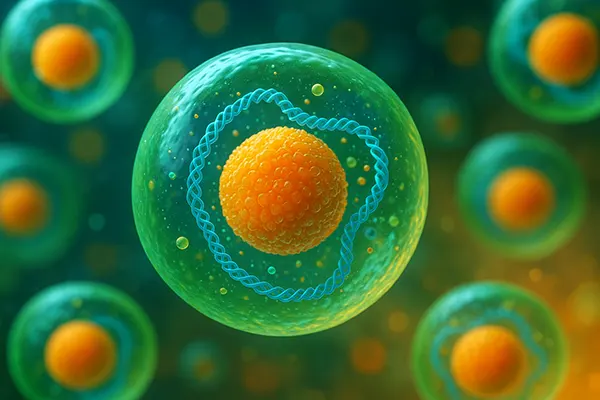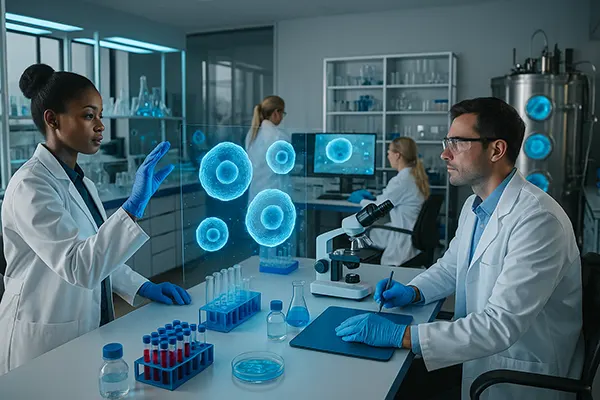Phenotypic Adaptation of Artificial Biosystems: How Programmed Cells Are Created

In recent years, biotechnology has advanced towards designing artificial biosystems that can adapt and respond to environmental cues in ways similar to living organisms. This process, known as phenotypic adaptation, allows synthetic cells to modify their behaviour based on internal programming and external stimuli. By 2025, these innovations have moved beyond laboratory prototypes and entered applied research in medicine, environmental monitoring, and sustainable energy.
The Concept of Phenotypic Adaptation in Synthetic Biology
Phenotypic adaptation refers to a cell’s ability to alter its observable characteristics, or phenotype, without changing its genetic code. In artificial biosystems, this principle is applied to create programmable cells capable of self-adjustment in dynamic environments. Through advanced gene regulation systems and synthetic circuits, researchers can dictate how these cells behave when faced with specific conditions such as temperature changes or chemical signals.
In 2025, laboratories employ CRISPR-based editing and modular genetic components to design adaptive responses that mimic evolution in real time. Instead of waiting for random mutations, scientists can now insert logic gates made of DNA that trigger predefined actions, such as releasing therapeutic molecules or degrading pollutants. This approach represents a shift from static engineering to dynamic, learning-like cellular systems.
Phenotypic adaptation thus provides artificial cells with an advantage: they can remain functional under varying conditions while maintaining biological stability. Such adaptability is a cornerstone for future biomedical applications where environmental unpredictability is the norm, like within human tissues or ecological restoration projects.
Mechanisms Behind Cellular Programming
Creating a cell with “programmed” behaviour involves multiple layers of biological design. The first layer uses genetic circuits—synthetic gene networks that act as molecular software. These circuits define how a cell senses, processes, and responds to stimuli. By integrating multiple circuits, scientists can build complex decision-making pathways within living matter.
The second layer relies on signal transduction systems that interpret environmental data. Modern synthetic cells employ engineered receptors that recognise light, pH, or chemical gradients. When these receptors are activated, they trigger a cascade of reactions that lead to visible phenotypic changes, such as fluorescence, movement, or secretion of specific proteins.
The final layer focuses on cellular memory. Recent studies have developed RNA-based memory systems that allow artificial biosystems to “remember” past stimuli. This means a cell can respond differently depending on its exposure history, enabling learning-like behaviour similar to neural processing at a microscopic scale.
Applications in Medicine and Environmental Science
One of the most promising fields for programmable biosystems is medicine. Engineered cells are now being tested as living drugs capable of detecting diseases and producing treatments on demand. For instance, adaptive bacteria have been designed to recognise cancerous tissues and release anti-tumour agents only when specific biomarkers are present. This reduces side effects and increases therapeutic precision.
Environmental applications have also expanded in 2025. Synthetic microbes with adaptive phenotypes are used to neutralise oil spills, remove microplastics, and stabilise soil ecosystems. Their ability to alter metabolic pathways allows them to survive in polluted areas and continue performing essential functions without human intervention.
Moreover, adaptive biosystems have begun contributing to climate resilience strategies. Bioengineers are exploring ways to create photosynthetic organisms that can adjust to changing CO₂ levels and light intensity, enhancing carbon fixation and sustainable energy conversion in variable climates.
Ethical and Safety Considerations
While the potential of adaptive biosystems is vast, their development requires strict ethical oversight. Programmable cells, by design, can evolve autonomously, which raises concerns about containment and ecological balance. Regulatory agencies in 2025 have implemented global biosafety frameworks ensuring that synthetic life forms cannot survive outside controlled environments unless they include built-in fail-safe mechanisms.
Researchers must also consider biosecurity risks. The same tools that enable medical innovation could be misused if not properly monitored. As a result, international collaborations now focus on transparency, open-access databases, and ethical AI integration to prevent unintended consequences in the design of living systems.
Public understanding plays a crucial role as well. Scientists increasingly communicate their findings in accessible language to build trust and counter misinformation surrounding biotechnology. Informed engagement ensures that society benefits from these technologies responsibly and equitably.

The Future of Artificial Phenotypes
By 2025, the convergence of biotechnology and artificial intelligence has accelerated the evolution of phenotypic programming. Machine learning models assist in predicting cellular responses, allowing faster optimisation of genetic designs before they reach the lab. This integration shortens research cycles and reduces experimental uncertainty.
Next-generation biosystems are expected to integrate synthetic organelles—engineered compartments that perform specific adaptive tasks. These mini-structures can regulate energy flow, produce signalling molecules, or control reproduction rates depending on environmental demands. Their modular design allows scientists to assemble highly specialised cellular functions.
In the near future, artificial phenotypic adaptation could underpin innovations in space exploration and longevity research. Cells that self-repair and adapt to radiation or nutrient scarcity may become essential for sustaining life in extraterrestrial habitats, marking a new era of human-machine symbiosis in biological form.
Global Collaboration and Governance
International cooperation remains a decisive factor in managing the growth of synthetic biology. Organisations such as the OECD and the World Health Organization have initiated joint programmes to establish global standards for bioengineering safety. These frameworks aim to balance innovation with environmental and ethical responsibility.
Academic and industrial partnerships now define the landscape of biotechnology. Universities, startups, and pharmaceutical corporations share resources through open research networks, accelerating discoveries while maintaining public accountability. This collaborative ecosystem strengthens trust and ensures transparent scientific progress.
Ultimately, the governance of artificial biosystems must evolve alongside the technology itself. As programmable cells become more integrated into everyday life, legislation will need to adapt to emerging ethical challenges. Continuous dialogue between scientists, policymakers, and the public is essential to ensure that phenotypic adaptation serves humanity safely and sustainably.
